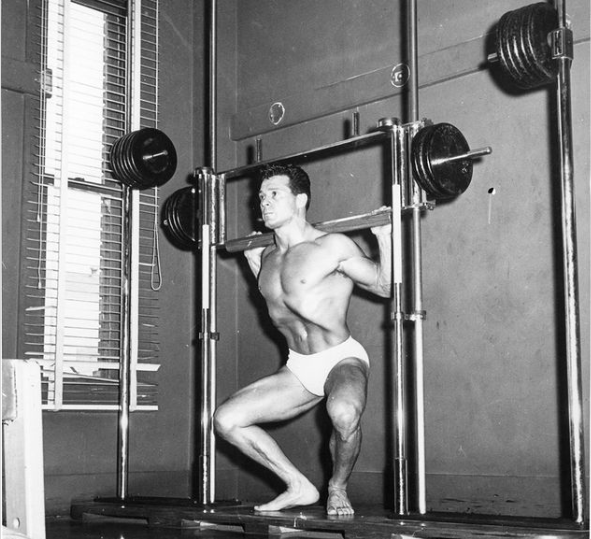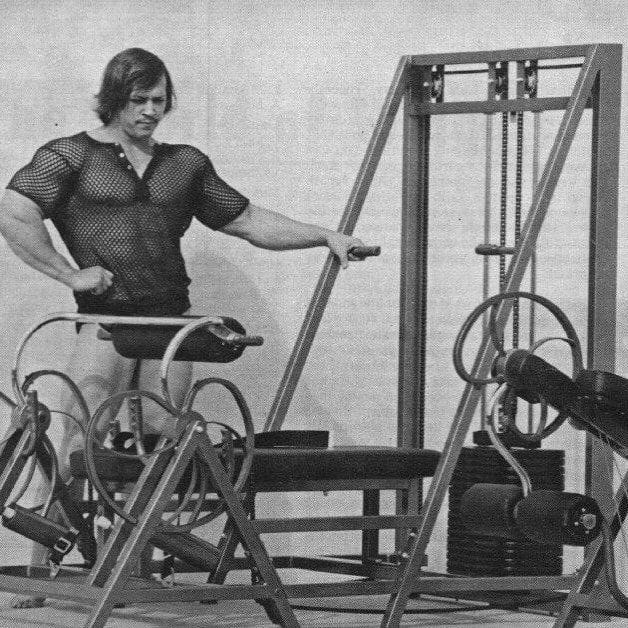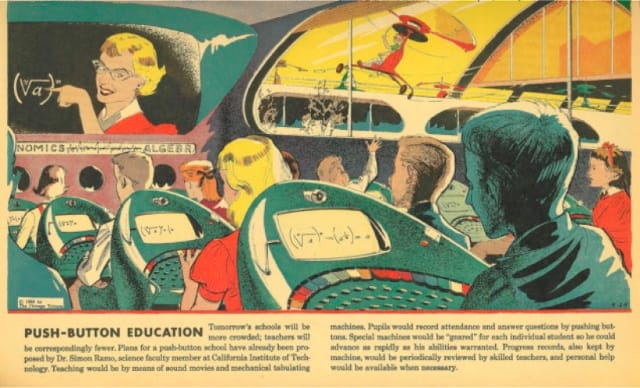The History (of the Future) of Weightlifting Machines

The debate over which is better for muscle development — free weights or machines — is a long one, and I'll just state here at the outset of this essay, really beyond the scope of the kinds of stories I tell here at Second Breakfast. You can definitely find the research to back up whichever position you might take — likely the one that matches your preference for and level of comfort with a certain piece of gym equipment or different forms of exercise. You should be lifting weights — heavy weights, even; but I'm not going to insist that you move those weights with a barbell or, alternately, via a more complicated pulley or hinge mechanism; I'm not going to sneer if you prefer the Smith Machine to the squat rack.
But I do want us to stop and consider, say, how and why the Smith Machine came about. That's the interesting bit for me: why machines.
How and why the Smith Machine came about: The Smith Machine was built by bodybuilder Rudy Smith, based on a back-of-the-napkin sketch that he and famed fitness guru and gym owner Jack LaLanne brainstormed together at dinner one night: a way to perform a heavy barbell squat without the need for a spotter —someone to help you safely re-rack the weight if the lift goes awry. LaLanne, surely one of the 20th century’s greatest fitness influencers, is often given sole credit for inventing the Smith Machine, which contains a barbell fixed within a rail system, prevents the lifter from falling over (crushed, I guess, by the weight on the bar) and allows the weight to be re-racked at any point with just the twist of the wrist. Again, let's sidestep the never-ending debate over what's better — a barbell squat or a Smith Machine squat — and stress this point instead: Jack LaLanne was particularly concerned that, as weightlifting and gyms were becoming more popular in the 1950s, the general public would not be able to safely lift barbells.

Weightlifting machines continue to be framed this way: they're safer, particularly for novices. Note: that's a frame, not necessarily a fact.
Of course, weightlifting was, for a long, long time, seen as an activity solely engaged in by "strongmen" and, even until quite recently, those who were part of the bodybuilding subculture. These individuals — mostly men — worked out together in places like Muscle Beach in Venice, California. They worked out together for many many hours, many days a week, mostly with free weights — big dumbbells and barbells. They trained one another; they spotted one another; they taught one another. (They also competed with one another and hated one another and wrote a lot of bullshit in various fitness magazines — that’s a whole other story.)
As gym attendance began to expand in the later half of the 20th century, this subculture was not particularly welcoming, to put it mildly. And so for a variety of reasons — I mean, not everyone lived near Muscle Beach, if nothing else — many folks went to the gym alone; they worked out alone. And machines meant they could lift even very heavy weights alone. Gym owners readily invested in these devices, which were sold to them with the promise of not needing to hire spotters or instructors or trainers.
Weightlifting machines also promised an efficient workout — and this is key. Efficiency and optimization were central to the marketing message for the Nautilus, a weightlifting machine designed to maintain equal resistance on the muscle you're focused on throughout the lift. (Think about a dumbbell bicep curl. Lifting the weight — curling — is much harder on your bicep than lowering the weight — straightening your arm. The Nautilus machine works in such a way that the resistance on your bicep is the same throughout the movement.)
Arthur Jones invented the Nautilus machine in the 1960s — and this was certainly not the first weightlifting machine on the market, but Jones, like LaLanne, is often credited with transforming the fitness industry, not simply because of his machine, but because of his accompanying exercise philosophy, his routine. From his son's memoir:
Nautilus equipment, used properly, allowed people to work out more efficiently. There was, and continues to be, an argument about which is better, free weights or machines. Certain muscles cannot be exercised effectively without machines; nor do free weights have the safety advantages of machines. Most people were being taught that to get big muscles they had to use free weights, workout five or more times a week, spend five or more hours a day in the gym, and do multiple sets of each exercise. Arthur, however, preached you should only workout two or three times a week, you should only do one set of each exercise, and each exercise should be done to the point of momentary muscular failure; a proper Nautilus workout took only 20 to 30 minutes.

There is a lot more to be said about Nautilus and Arthur Jones — not much of it very good, I reckon. Obituaries called him "flamboyant" and "rough and tumble," which are euphemisms at best. I've written before about the history of fitness and fascism, the connections between reactionary politics and "physical culture" — and I suppose those connections do bear repeating. But I’ll skip the details of Jones’s biography, for now.
Nevertheless, I think we can still study the design, the vision for, and the adoption of exercise machinery — from its origins in the Victorian era and in the Industrial Revolution, to its eventual ubiquity in gyms one hundred years later — and the way in which it exposes the ideological underpinnings of machinery writ large, then and now. Efficiency. Optimization. Speed. Control. Precision. Fantasies of the male body, perfected. Fantasies of femininity, repressed.
The gym of the future, Jones argued in 1979, would not simply by mechanized; it would be computerized.
Enter the gym of the future, pull your pre-programmed plastic card out of the file and insert it into a slot in the machine... and from that moment on, the machine will tell you exactly what to do, how to do it, how hard to do it, and how often to do it. And keep an accurate permanent record of what you actually do.
As soon as your card is inserted, your number will appear on the first of several exercise machines. Which machines will be instantly and automatically set for you; with careful consideration for all of your individual requirements, your existing strength level, your degree of flexibility, your cardiovascular ability, your age, your previous medical history, and any other important considerations.
The level of resistance? Whatever you require, at that point in time.
People often praise these sorts of predictions as prescient — that somehow, in an era before even the personal computer, Jones was brilliant and imaginative enough to understand the potential for a personalized fitness machinery. Perhaps. Or perhaps this is really just the same “future of…” that almost industry had been imaging since the end of the Second World War — it’s less technological innovation and more pop culture repetition.
Jones’s future is, of course, for those familiar with my book Teaching Machines, strikingly similar to the vision of the future of education penned by Simon Ramo, "the father of the intercontinental ballistic missile," in his 1957 article "A New Technique of Education," — an essay made famous in Arthur Radebaugh's Closer Than We Think comic, published the following year, depicting "push button education."
First of all, we will get the student registered. I won’t burden you with the details here: when the registration is complete and the course of study suitable for that individual has been determined, the student receives a specially stamped small plate about the size of a “charga-plate,” which identifies both him and his program. (If this proves too burdensome for the student, who will be required to have the plate with him most of the time, then we may spend a little more money on the installation and go directly to the fingerprint system)
When this plate is introduced at any time into an appropriate large data and analysis machine near the principal’s office, and if the right levers are pulled by its operator, the entire record and progress of this student will immediately be made available. As a matter of fact, after completing his registration, the student introduces his plate into one machine on the way out, which quickly prints out some tailored information so that he knows where he should go at various times of the day and anything else that is expected of him.

Ramo (and the generations of ed-tech "innovators" who've followed) argues that the mechanized schools of the future will be better at maintaining students' interest and engagement, particularly when they struggle with the material; Jones argues that the computerized gyms of the future will be much better at correcting form and maintaining high intensity, "keeping an instant and exact record of your workouts when they need changing. Sensing and reacting to any reasonable number of physiological factors, pulse, blood pressure, and other factors."
Why is the future of school and of exercise still today the future as imagined by men born almost a century ago?
The push button school and the push button gym — this vision of the future that rests on the elimination of human labor, the optimization of mind and body through the collection of data, through the engineering of movement and study patterns. It's a cartoon vision; and yet it was (it is?) so compelling to the men who're lauded as the visionaries of their field.
Thanks for subscribing to Second Breakfast. I have such a jumble of thoughts about the history of these machines, but when I read Jones' essay on the gym of the future, I knew I had to quickly throw together some thoughts on the similarities to the push button school. Next step, I guess, is figuring out what to make of all this. Meanwhile, consider becoming a paid subscriber – doing so is a good way to support my writing and thinking, which clearly need some support.





